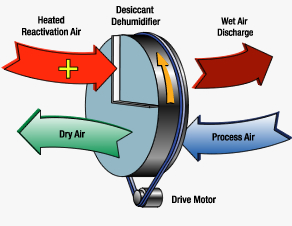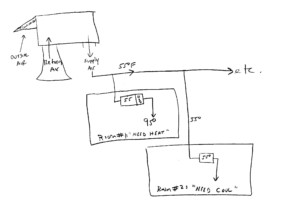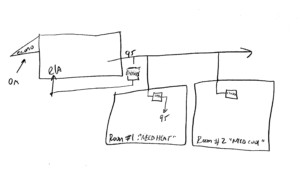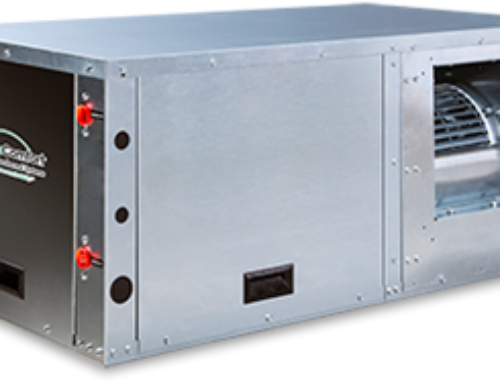There are many reasons why zoning is required for any space. A two story home having two split systems is the simplest example: During the day, you put the upstairs in occupied setback (ie, 10 degrees cooler in the winter, 10 degrees warmer in summer) and at night it would be reversed. This logic increases energy savings and comfort.
Zones can be divided even further, using dampers (VAV Boxes or Zone Dampers) and this white paper is intended to explain the commercial applications.
If you consider a medium or large office, it is pretty common to have exterior zones (spaces with windows and/or walls exposed to the elements) and interior zones (no windows and walls). Interior zones have people, lighting and office equipment constantly adding heat all year round.
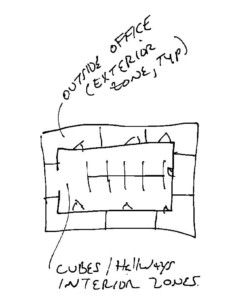
interior vs exterior zone example floor plan
Exterior zones also have this head load, but in the winter will have skin losses (heat loss). As a result, typically, interior zones will require cooling all year round but the exterior zones will need heat when its cooler outside. All zones always require a certain amount of outside air.
A VAV “Variable Air Volume” System consists of multiple Dampers (VAV Boxes) which will modulate open and closed based on what each zone is calling for with 55 degree air coming from the main HVAC unit. In the cooler months, the HVAC will use its economizer (“free cooling” taking advantage of the colder air outside). On the exterior zones, the VAV box can be outfitted with heat (typically electric or hot water) which will raise the temperature from 55 to 95F. The interior zones will get the cooling as required. Every zone will be satisfied by varying the amount of air flow and cycling or modulating individual heat.
In a VAV system, the central VAV system will typically run in cool mode and as the zones go to minimum position and less air is required, the central unit will slow the fan down, typically using a VFD (variable frequency drive). As an added feature, for early mornings in the winter where all spaces are cold, the unit may have a morning warmup feature where the heat will come on, fan “100%” and deliver 95F to all the spaces until satisfied.
As technology advances, we have seen the price of VFD’s lower in HVAC equipment. While most sizes of units are with available speed control, it is still common to see VFD’s in equipment in 20 tons and higher.
That being said we have seen VVT systems more prevalent in systems below 20 tons. VVT (Variable Volume, Variable Temperature) is a zoning system otherwise known as a polling system. Typically at a lower price point and used for constant volume systems, every zone, interior and exterior (note that it is not uncommon that there are no interior zones) would be tied back to the HVAC unit which would switch from cooling to heating. As the zone dampers go to minimum, the pressure in the duct would build and a bypass damper would open (or the VFD would slow the fan down). This would allow the excess supply air to return back to the HVAC unit, allowing it to reset. The VVT system is allowing full zone capability for constant volume HVAC Units.
Consider for example, a 10 ton unit (4000 cfm) with 10, 400 cfm zone dampers. At a point consider 3 zones calling for heat, 2 satisfied, and 5 calling for cool. When the unit goes into cool, the satisfied and cold zones will be at minimum and the 3 zones are getting the whole units attention for heat, which will complete its task relatively quick. Once this is the case, the unit will switch to heat where the opposite sequence will occur. Please also note that in ideal situations, for smaller systems, it is not uncommon to see all the zones in the same mode (all need cool or all need heat, but different levels). In that case, the HVAC Unit would be in one mode and the zone dampers would cycle as required. Taking that to the next level, you can have a unit dedicated to the south side and north side of a building, for example, or an exterior zone and an interior zone.
There are also hybrids in zoning systems. Individual zones can be created by thermal diffusers (combination diffuser and VAV) or allowing 1 zone damper on a constant zone system. Essentially, there would be a sensor in the duct and a sensor in the space. If the space required heating or cooling and the air in the supply would satisfy (ie cool air and the space is warm) the damper would open to satisfy.
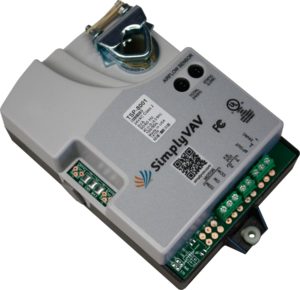
Device which will control each zone actuator with or without auxiliary heat

Zone Controller (Typically used in VVT)

VAV Box with Hot Water Heat
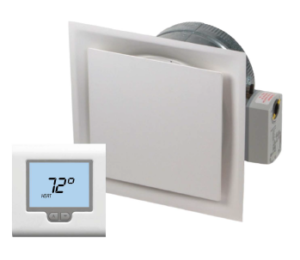
Carnes Thermal Diffusers Combine A Zone Damper with the Outlet
Need Design or Sales Assistance? Call Us!
973-536-2220


